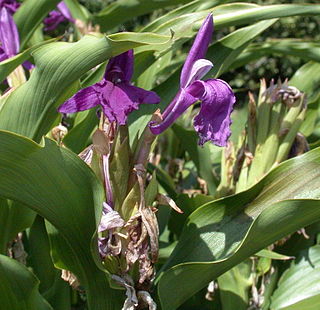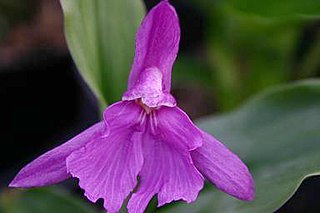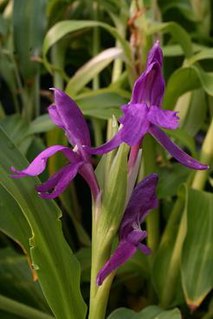Description
Roscoea australis is a perennial herbaceous plant. Like all members of the genus Roscoea, it dies back each year to a short vertical rhizome, to which are attached the tuberous roots. When growth begins again, "pseudostems" are produced: structures which resemble stems but are actually formed from the tightly wrapped bases (sheaths) of its leaves. [2] Plants are usually 11–16 cm (4.3–6.3 in) tall, occasionally up to 30 cm (12 in), with four to six leaves. The first two or three consist only of whitish sheaths, which may be speckled; the remaining leaves form a rosette and have blades usually 6–10 cm (2.4–3.9 in) long by 2–3 cm (0.8–1.2 in) wide (although lengths and widths outside this range are also found). The sheaths have small 'ears' (auriculate) at the junction of the blade and sheath where there is also a small ligule which extends to about 1.5 mm (0.1 in). [3]
Flowers appear in May to July in the wild. The stem (peduncle) of the flower spike (inflorescence) is held within the leaves. The few flowers open one at a time and are purple or white. The bracts which subtend the flowers are shorter than the calyx. Each flower has the typical structure for Roscoea (see the diagrams in that article). There is a tube-shaped outer calyx which is spotted and pink-brown in colour, with a bluntly three-lobed apex. Next inwards the three petals (the corolla) form a white tube, protruding considerably from the calyx, terminating in three lobes, a hooded upright central lobe, about 2.2–3 cm (0.9–1.2 in) long by 1.7–2 cm (0.7–0.8 in) wide, and two narrower side lobes, about 1.9–2.6 cm (0.75–1.02 in) long by about 6–8 mm (0.2–0.3 in) wide, which are whitish at the base. Inside the petals are structures formed from four sterile stamens (staminodes): two lateral staminodes form what appear to be small upright purple petals, which are 1.3–2.2 cm (0.5–0.9 in) by 6–9 mm (0.2–0.4 in), with a non-central vein; two central staminodes are partially fused at the base to form a lip or labellum, 2–3 cm (0.8–1.2 in) long by about 1.9–2.4 cm (0.7–0.9 in) wide. The labellum is split into two lobes at the end for about half of its length. [3] [2]
The single functional stamen has a white anther, about 5–6 mm (0.2 in) long, with 6–7 mm (0.2–0.3 in) long spurs formed from the connective tissue between the two capsules of the anther. The seeds when they form are dark brown. [3]

Roscoea is a genus of perennial plants of the family Zingiberaceae. Most members of the family are tropical, whereas Roscoea species are native to mountainous regions of the Himalayas, China and its southern neighbours. Roscoea flowers superficially resemble orchids, although they are not related. The flowers of Roscoea have a complicated structure, in which some of the showy coloured parts are not formed by petals, but by staminodes, sterile stamens which have evolved to become like petals. Some species are grown as ornamental plants in gardens.

Roscoea auriculata is a perennial herbaceous plant occurring in the eastern Himalayas, in Tibet, Bhutan, Nepal and Sikkim. Most members of the ginger family (Zingiberaceae), to which it belongs, are tropical, but R. auriculata, like other species of Roscoea, grows in much colder mountainous regions. It is sometimes grown as an ornamental plant in gardens.

Roscoea humeana is a species of flowering plant in the Zingiberaceae family. It is a perennial occurring in the Sichuan and Yunnan provinces of China. Most members of the ginger family, to which it belongs, are tropical, but R. humeana, like other species of Roscoea, grows in much colder mountainous regions. It is sometimes grown as an ornamental plant in gardens.

Roscoea purpurea is a perennial herbaceous plant occurring in the Himalayas, particularly Nepal. Most members of the ginger family (Zingiberaceae), to which it belongs, are tropical, but species of Roscoea grow in much colder mountainous regions. It is sometimes grown as an ornamental plant in gardens.

Roscoea alpina is a perennial herbaceous plant native to the Himalayas. Most members of the ginger family (Zingiberaceae), to which it belongs, are tropical, but R. alpina, like other species of Roscoea, grows in much colder mountainous regions. It is sometimes grown as an ornamental plant in gardens.

Roscoea tibetica is a perennial herbaceous plant native to the mountains of China, being found in Tibet, Sichuan and Yunnan. The species formerly included plants found in Bhutan; in 2000, these were separated into a new species, Roscoea bhutanica. Most members of the ginger family (Zingiberaceae), to which it belongs, are tropical, but R. tibetica, like other species of Roscoea, grows in much colder mountainous regions. R. tibetica is sometimes grown as an ornamental plant in gardens. In 2020, it was proposed that R. tibetica be split again.

Roscoea kunmingensis is a perennial herbaceous plant native to the mountains of China, being found in Yunnan. Most members of the ginger family (Zingiberaceae), to which it belongs, are tropical, but R. kunmingensis, like other species of Roscoea, grows in much colder mountainous regions.

Roscoea capitata is a perennial herbaceous plant native to the Himalayas, being found in Nepal. Most members of the ginger family (Zingiberaceae), to which it belongs, are tropical, but R. capitata, like other species of Roscoea, grows in much colder mountainous regions.

Roscoea forrestii is a perennial herbaceous plant occurring in the Sichuan and Yunnan provinces of China. Most members of the ginger family (Zingiberaceae), to which it belongs, are tropical, but R. forrestii, like other species of Roscoea, grows in much colder mountainous regions. It is sometimes grown as an ornamental plant in gardens. It was named after George Forrest (1873-1932) who discovered it in Yunnan.

Roscoea tumjensis is a perennial herbaceous plant occurring in the Himalayas, in Nepal. Most members of the ginger family (Zingiberaceae), to which it belongs, are tropical, but R. tumjensis, like other species of Roscoea, grows in much colder mountainous regions.

Roscoea praecox is a perennial herbaceous plant occurring in the Yunnan province of China. Most members of the ginger family (Zingiberaceae), to which it belongs, are tropical, but R. praecox, like other species of Roscoea, grows in much colder mountainous regions. It is sometimes grown as an ornamental plant in gardens.
Roscoea bhutanica is a perennial herbaceous plant native to the mountains of Bhutan and Tibet. Formerly regarded as part of Roscoea tibetica, it was recognized as a separate species in 2000. Most members of the ginger family (Zingiberaceae), to which it belongs, are tropical, but R. bhutanica, like other species of Roscoea, grows in much colder mountainous regions.
Roscoea brandisii is a species of herbaceous flowering plant in the Zingiberaceae family. It is a perennial found in the state of Meghalaya, India. Most members of the ginger family, to which it belongs, are tropical, but R. brandisii, like other species of Roscoea, grows in much colder mountainous regions.

Roscoea nepalensis is a perennial herbaceous plant found in Nepal. Most members of the ginger family (Zingiberaceae), to which it belongs, are tropical, but R. nepalensis, like other species of Roscoea, grows in much colder mountainous regions.

Roscoea debilis is a perennial herbaceous plant found in Yunnan, China. Most members of the ginger family (Zingiberaceae), to which it belongs, are tropical, but R. debilis, like other species of Roscoea, grows in much colder mountainous regions.
Roscoea schneideriana is a perennial herbaceous plant found in China, in Tibet, Sichuan and Yunnan. Most members of the ginger family (Zingiberaceae), to which it belongs, are tropical, but R. schneideriana, like other species of Roscoea, grows in much colder mountainous regions.
Roscoea ngainoi is a perennial herbaceous plant occurring in the Ukhrul district of Manipur state, India. Most members of the ginger family (Zingiberaceae), to which it belongs, are tropical, but like other species of Roscoea, R. ngainoi grows in much colder mountainous regions.
Roscoea ganeshensis is a perennial herbaceous plant occurring in Ganesh Himal in central Nepal. Most members of the ginger family (Zingiberaceae), to which it belongs, are tropical, but like other species of Roscoea, R. ganeshensis grows in much colder mountainous regions. It is used as an ornamental garden plant, requiring moisture and shade in the summer.

Roscoea wardii is a perennial herbaceous plant occurring from eastern Arunachal Pradesh in India to western Yunnan in China. Most members of the ginger family (Zingiberaceae), to which it belongs, are tropical, but like other species of Roscoea, R. wardii grows in much colder mountainous regions.

Roscoea scillifolia is a perennial herbaceous plant occurring in Yunnan in China. Most members of the ginger family (Zingiberaceae), to which it belongs, are tropical, but like other species of Roscoea, R. scillifolia grows in much colder mountainous regions. As of 2013, the species is only known in cultivation and may be extinct in the wild.














